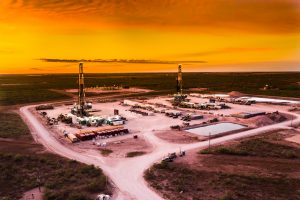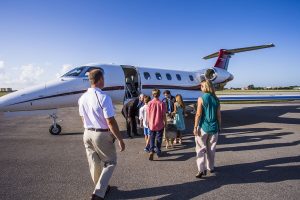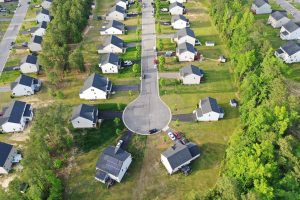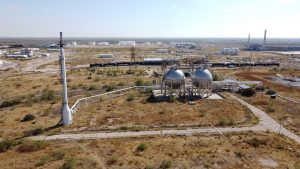
When a handshake and face-to-face time are important for a business deal, Nicholas Air flies oil company executives across Texas and to many other places.
The airways over the Permian Basin have long been highways to elsewhere for people traveling for business or pleasure. In recent years the advent of drones hauling cameras and other monitoring equipment has added another dimension to the skies.
Oxford, Mississippi-based Nicholas Air’s connection with the Permian Basin began quietly, with just one family, a few years ago. Now, said company president Peder von Harten, the company is reportedly the area’s most popular nationally available charter option, flying from both Midland International Air and Space Port and Midland Airpark. “I would say that we really hit our stride in the past four years,” von Harten said. He credits enthusiastic word-of-mouth outreach for the expansion of business.
Clients typically travel to Austin or Waco (football games), Dallas, Horseshoe Bay, Port O’Connor, and other places from Midland. For business, von Harten sees most deals being done in town, not requiring travel. “I don’t see the guys that are getting on a plane flying to New York looking for a finance meeting,” he said.
Face to Face, Not Face to Screen
Understandably, von Harten is not a fan of virtual meetings, saying that he never does any. He does take the occasional phone call (this interview was one of them), but if someone tells him they’ve prepared a visual presentation, he says, “I’m not going to see it.” When they quiz him about it, he replies, “I’m in the business of getting people to pay large amounts of money to go from point A to point B to see each other in person. Why would I want to accept a meeting that flies in the face of that?”
Surprisingly, Nicholas Air’s business grew dramatically during and after the Pandemic, during which Zoom and Teams grounded many business flyers—some vowing never again to travel for any meeting they don’t have to attend in person.
But von Harten says his typical customer agrees with his aversion to screen meetings and “still really enjoys the grip-and-grin of a handshake and the face-to-face value of a deal. As a company, during the Pandemic, we didn’t change a thing. We kept operating, all of our pilots stayed employed.”
Most Permian deals involve one party saying, “I’m about to hand you a lot of money,” he said, adding an example. “When you’re playing blackjack you want to look the dealer in the eye, and that’s really what being in the oil business is.”
Today’s business deals now can involve more than a billion dollars—where a phone call or video call would be completely unthinkable.
Von Harten comes to Midland regularly, where he says he’s made a lot of friends. “We go to events together, we go out to the deer lease together, and that really strengthens the relationship.”
The 25-year-old company’s website talks about its Hollywood and New York A-List clients, which seems odd to the casual observer, seeing that the company is based in a college town in Mississippi. For von Harten, however, the location makes obvious sense. “When I look at Oxford, Mississippi, I’m centrally located. I can touch every coast (East, West, and Gulf) with our fleet every day if I really want to. So as I think through that, why wouldn’t I be in Oxford?” It’s also within easy reach of the Caribbean and Mexico, he added.
Flying on the Side
For one Midlander, flying 737s for a living just wasn’t enough aerial interaction. Fulltime Southwest Airlines pilot Jamie Linderman also owns and operates Permian Basin Drone Services, LLC, when he’s on the ground.
His drones take to the air to get both still and video photographs for inspections, pipeline route planning, and oilfield site planning. He also does .kml photography. The Open Geospatial Consortium’s website refers to kml as “international standard language for expressing geographic annotation and visualization on existing or future web-based online and mobile maps (2d) and earth browsers (3d).” It provides photogrammetry, which does some correction on edge distortions common to aerial photography due to the curvature of the earth.
Toward the Storm
Linderman, who founded the company, became interested in flying due to a San Angelo high school friend whose father was a pilot for the U. S. Customs office there. “I asked him where one could go to learn how to fly, and he took me to Skyline aviation, a flight school that had just opened up.” For a kid who’d grown up drawing pictures of airplanes and had traveled to Midland more than once for the airshow, that was a dream come true.
His first real piloting job involved flying single-engine Piper Comanches to seed clouds for the West Texas Weather Modification Association. The plane carried more than 100 flares containing silver iodide aimed at boosting rainfall from storm clouds. He admits that flying toward a storm is normally frowned upon. “Everything you’re taught tells you to go away from them. But you get in this program and you’re flying at them.”
Later he moved to Midland, where he spent almost 11 years flying charters at two of the top locally owned companies. Then he joined Southwest Airlines to get more control over his life.
The move to Southwest gave Linderman more control over his schedule than he’d had. With charters, “You’re kind of tied to your cell phone,” he said. “With charters people could call at any time,” 24/7.
His most challenging trip involved a New Year’s Eve auction in Andrews, that offered a trip to Las Vegas—that evening. The challenge for Linderman was, “I didn’t know that.”
The next challenge was that he couldn’t fly to Andrews to pick them up, due to fog. So the winners finished the auction, had dinner, went home to pack, then drove about an hour to Midland. “I think we left Midland around 8 or 9 p.m.,” he recalled.
On the positive side, he and his copilot got to watch an amazing fireworks show off the tops of several Vegas hotels, so, “It ended up being a pretty cool trip.”
Have Drone, Will Travel
His drone introduction came from a Southwest captain who was approaching retirement. “When I asked him what he was going to do to stay busy, he told me about getting his Part 107, or commercial drone operator’s license. It sounded pretty interesting and, after learning about it, I became fascinated.” Admitting to being a tech nerd, Linderman said he majored in computer science for a while in college, so researching drones and their accompanying technology came naturally to him.
Plus, he had long considered opening his own business, so drones gave him that opportunity. He founded the company, in which he flies solo, in August of 2019.
Linderman’s first idea of drone use involved how they could safely approach oilfield flares without the need to shut off the flame. “That was the first idea I had.” For several reasons he decided not to do that, but the oilfield was still the obvious choice in which to start a drone service.
Some of his research led him to .kml. Using an app he downloaded, “I can create a flight plan that the drone automatically follows,” he said. In that realm he’s photographed the route of a proposed pipeline for a midstream company to show to interested parties. He’s also taken photos and videos of several kinds of oilfield sites, along with right-of-way photos for a legal issue.
Taking a series of site photos to show construction progress is another option. “I go to a site and fly a repeatable flight plane, and take a series of photos from the same spot,” he said. “Then you can see the progress of the job site as construction progresses.”
As the Environmental Protection Agency (EPA) continues to increase methane release regulations, it is likely that drones will be used more and more for monitoring and other uses in the oil patch. And with Midland’s distance from resorts and football games, the charter business has proven more resilient than most already.
Paul Wiseman is a freelance writer in the energy sector. His email address is fittoprint414@gmail.com.












